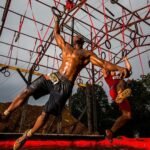Behind the Scenes: How Urban Race Courses Are Designed
Urban obstacle races like Metro Dash® are thrilling, challenging events that test participants’ physical and mental limits. But behind the excitement and adrenaline is a meticulous process of course design that ensures the race is not only challenging but also safe and engaging. Here’s an in-depth look at how urban race courses are designed:
1. Initial Planning and Conceptualization
The design process begins with the initial planning and conceptualization phase. Race organizers outline the goals of the race, the type of obstacles to include, and the overall experience they want to create. Key considerations at this stage include:
- Target Audience: Understanding the skill levels and preferences of the participants, from beginners to seasoned racers.
- Location Selection: Choosing a suitable urban environment that offers a mix of terrains and features conducive to obstacle placement.
- Theme and Branding: Deciding on a theme that aligns with the race’s branding and enhances the participant experience.
2. Scouting and Mapping the Course
Once the basic concept is established, the next step is scouting and mapping the course. This involves:
- Site Visits: Organizers conduct multiple site visits to identify potential routes, obstacles, and logistical considerations.
- Urban Features: Utilizing the city’s natural and architectural features, such as parks, alleys, stairs, and bridges, to create a dynamic and engaging course.
- Mapping Software: Using advanced mapping software to draft potential course layouts and visualize how obstacles will fit into the urban landscape.

3. Obstacle Design and Placement
Designing and placing obstacles is a critical aspect of course design. Each obstacle is carefully crafted to challenge participants in unique ways. This involves:
- Types of Obstacles: Incorporating a variety of obstacles that test different physical attributes, such as strength, agility, balance, and endurance. Common obstacles include rope climbs, monkey bars, wall climbs, and balance beams.
- Custom Obstacles: Creating custom obstacles that are unique to the event and align with its theme and branding.
- Safety Considerations: Ensuring all obstacles are safe and secure, with proper materials and construction methods. Safety mats, harnesses, and other protective measures are often used to minimize the risk of injury.
4. Logistical Planning
Logistics play a crucial role in the smooth execution of an urban race. This includes:
- Permits and Approvals: Obtaining necessary permits and approvals from city authorities for using public spaces and closing streets or parks.
- Participant Flow: Designing the course to manage the flow of participants, prevent bottlenecks, and ensure a smooth race experience.
- Support Stations: Placing water stations, medical tents, and rest areas at strategic points along the course to support participants.
5. Permits and Regulations
Organizers must navigate a maze of permits and regulations to host an urban race. This involves:
- Permitting: Securing permits from local authorities to use public spaces.
- Compliance: Ensuring compliance with local laws, especially regarding public safety, noise levels, and environmental impact.
- Coordination: Coordinating with city services for street closures, waste management, and emergency services.
6. Safety Measures
Safety is paramount in urban race course design. Organizers implement a range of safety measures, including:
- Medical Support: Having medical personnel and first aid stations strategically placed throughout the course.
- Obstacle Safety: Conducting thorough inspections of obstacles to ensure they are secure and stable.
- Participant Briefings: Providing safety briefings and clear instructions to participants before the race.
7. Testing and Adjustments
Before the race day, organizers conduct test runs to evaluate the course’s difficulty and safety. This allows them to:
- Identify Issues: Spot potential problems or bottlenecks in the course layout.
- Make Adjustments: Adjust the placement or design of obstacles as needed.
- Optimize Flow: Ensure the course flow is smooth and efficient.
8. Race Day Setup and Execution
On race day, the course is set up with all obstacles, signage, and support stations in place. Key tasks include:
- Final Inspections: Conducting final safety checks and ensuring all obstacles are secure.
- Volunteer Coordination: Briefing volunteers on their roles and positions.
- Participant Management: Organizing participant waves to manage course congestion and ensure a smooth race experience.
Conclusion
Designing an urban race course is a complex but rewarding process that involves creativity, meticulous planning, and a deep understanding of both the urban environment and participant needs. From the initial concept to race day execution, every step is carefully orchestrated to create a challenging, safe, and memorable experience for all involved. The next time you lace up for an urban obstacle race, you’ll have a deeper appreciation for the intricate design and planning that goes into transforming city streets into a thrilling racecourse.



